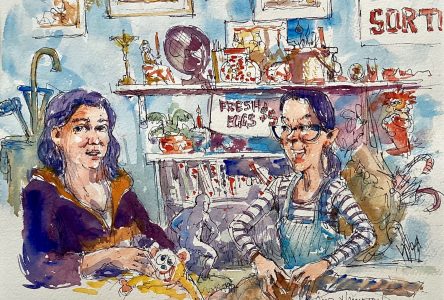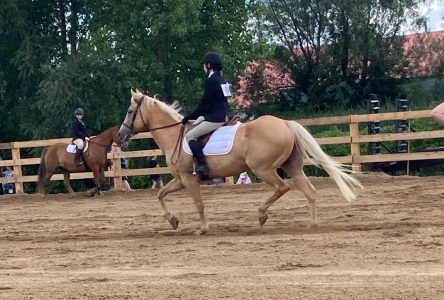Celebrating the arts in Brome-Missisquoi
Glass is constantly in motion. Whether it’s a stained glass window allowing light to pour through the interior of a dim church, a vase decorating a coffee table, or a suncatcher bathing at high noon, each layer contains movement perceptible to the eye, no matter the environment or time of day.
Artist Shelley-Lynn Page knows how to interpret the fluidity and textures of glass. The Vancouver-born stained glass artist has spent 43 years learning its forms and crafting it into intricate pieces of art, ranging from gargoyles to kitchen cabinets to spinning kaleidoscopes and more. Most of her creations are unique, meaning you’ll never find the exact same windows or lamps in her studio.
To see the movement of glass in action, Page invites us to look at a window in our house, observing how it will change several times throughout the day. Depending if the glass is cast in the light of morning, afternoon, evening, or pure darkness, we will be able to see different hues and textures on its smooth surface.
“Light isn’t essential to this form of art,” Page explains, as her diverse collections include decorative objects like bowls or pieces to be mounted on walls that hold different functions than windows. “One sheet of glass can have four, five, six different colours. But some things do look better with light coming through them.”
The creation of glass art is a particularly manual process, which Page begins by sketching out her ideas from her two-storey studio in West Bolton. Most of her creations are custom-made pieces, for which Page will listen to her clients’ desires and draw something that honours their vision, making the process as collaborative as possible. There are thousands of different types of glass to choose from, which vary in thickness and shades, with “some looking like the sky, some looking like water.”
Page aims to create glass art grounded in realism, avoiding abstract designs. After decades of honing her craft, she is able to look at a wide sheet of glass and cut right through the middle to get a tiny piece if she knows that’s what she needs.
In addition to her original designs, she also does glass repairs for antique windows, lamps, and the like, a process she takes on with meticulous care. Her studio contains a plethora of boxes filled with old 20th century glass that she collects from yard sales, retired glass hobbyists, and old homes being demolished. Glass production has changed drastically over the years, making it impossible to fix a window from the 1940s with the same exact glass that is sold nowadays. Page combs through her boxes of antique glass to find the perfect piece she needs for each repair, restoring old treasures to their glory days.
Glass permeates nearly every part of daily life, yet its artform is currently being threatened by rising costs of tools and materials. Many artisans across all artistic mediums seem to be faced with a similar problem, where the pricing of cheaply made goods in big box stores dictates people’s opinions of how much they think handmade art should be worth. Page finds that there’s a general misunderstanding about the process it takes to create her work, from ordering glass to turning it into a final product. Since glass itself is an extremely delicate material that can quickly become a danger, hobbyists and professionals alike must have a special room for it in their home, which can become a barrier to those wanting to try it out or invest in the process.
“I don’t want this art to die,” Page says. “People don’t understand how much work is involved. It’s the same for knitting. People want something from the dollar store for $5 that’s made by machines and has no heart. But how long will it last? Glass art will last forever.”
The long-lasting legacy of Page’s glass creations can be found most prominently at St-Edouard’s Church in Knowlton. Behind the main building, one of her windows is mounted over the front door of their summer church, stretching 12×6 feet tall. This beautifully striking piece depicts a calm view over Brome Lake, which she completed in separate sections due to its large scale. This vista was not her first large scale installation, as she also has a vast 4×15 foot piece on display in Vancouver.
For those who are curious about glass art, Page teaches glass art courses to students of all skill levels, eager to share her love for its form. She provides tools for her students, making it ideal for those who would like to experiment before diving in to purchase their own glass cutting tools.
Her studio is located at 36-2, ch. Glen, Bolton-Ouest, and open to visits by appointment at any time by calling 450-242-2663. She has ready-made pieces available for purchase, ranging from windows to vases to trinkets and more, and loves to work with clients to bring their own visions to life.


